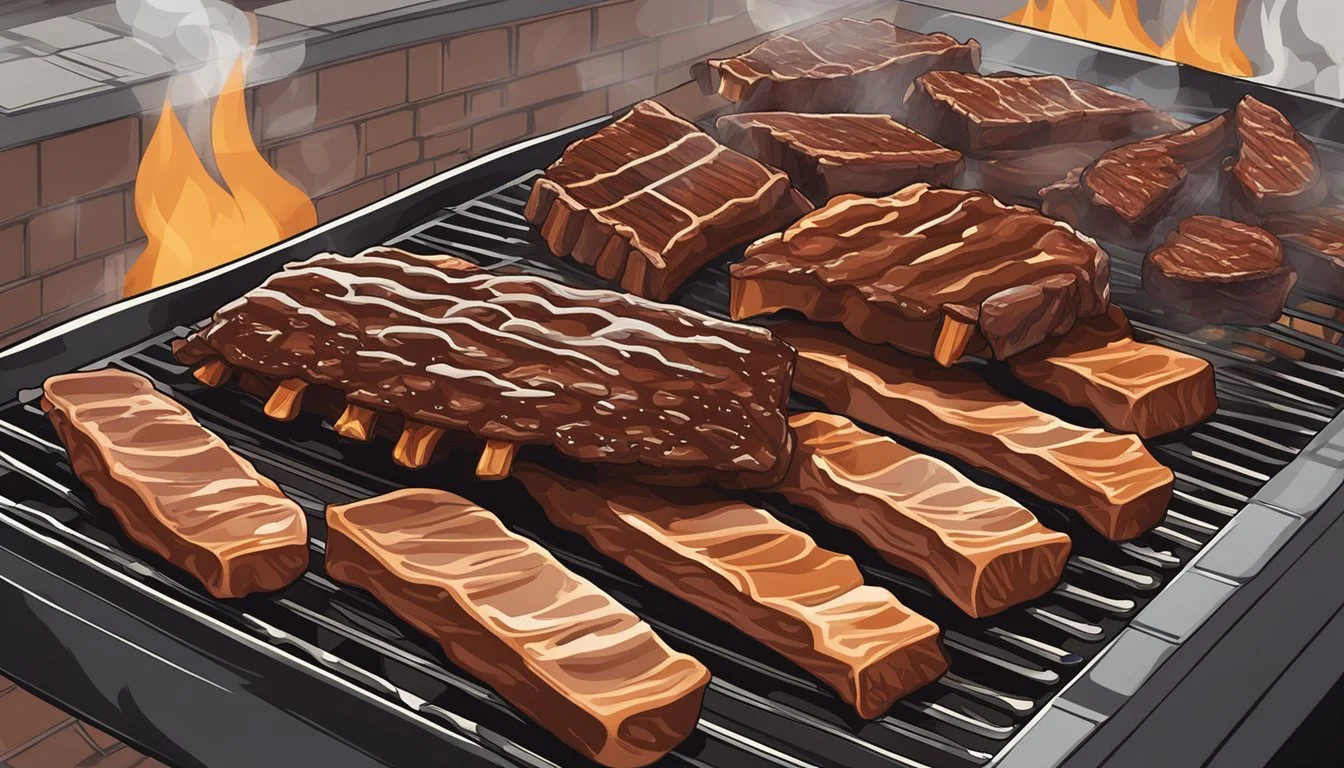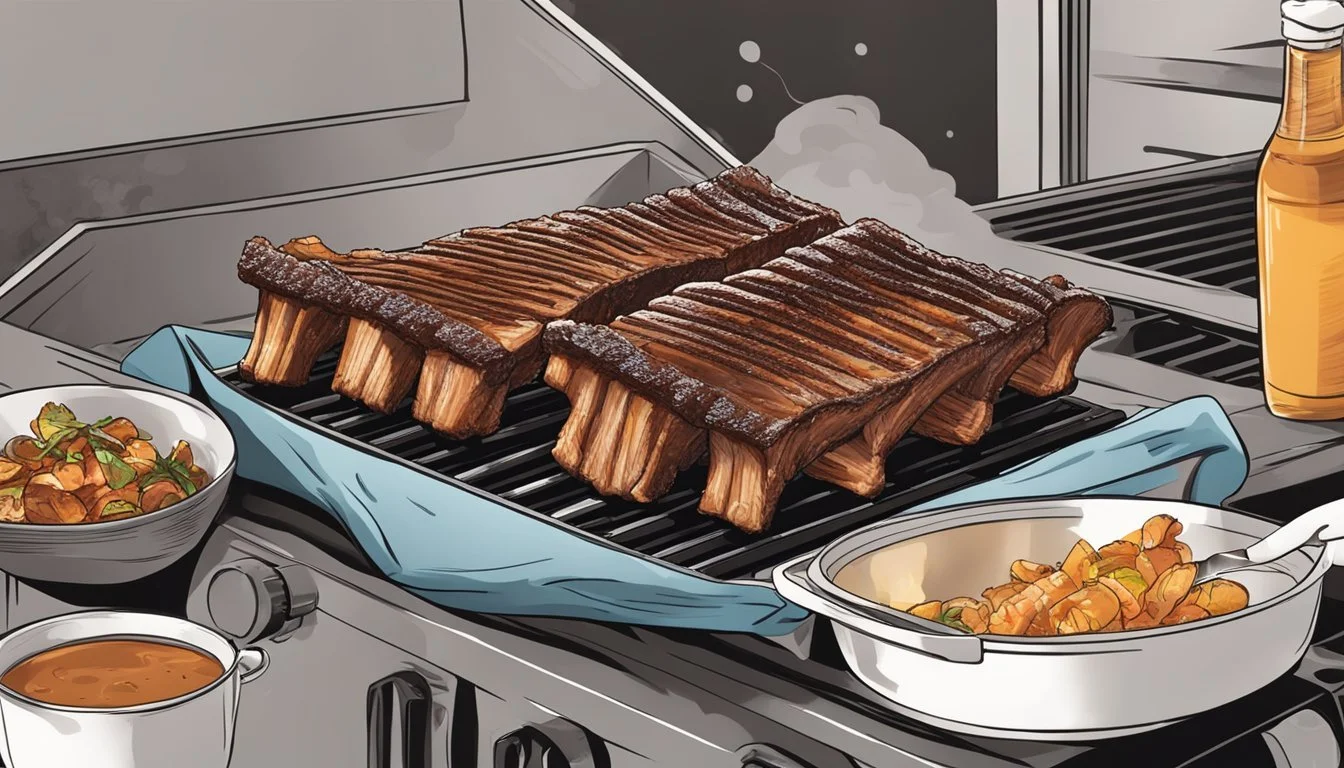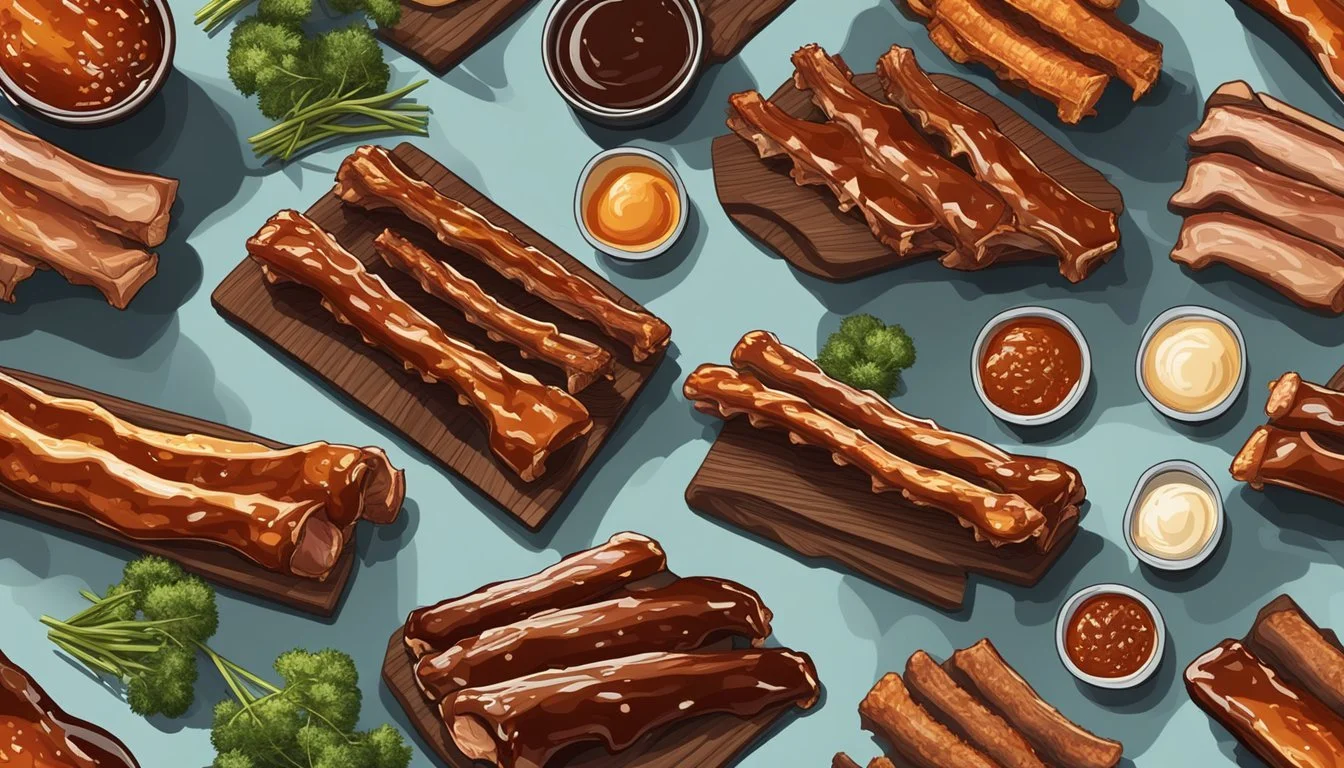BBQ Ribs, Pork Ribs, Back Ribs
Mastering the Art of Tantalizing Grilling
Barbecue ribs (What wine goes well with barbecue ribs?) are a quintessential comfort food, loved by many across the globe for their succulent and tender meat that falls right off the bone. Within this culinary world of barbecued (What wine goes well with barbecue?) goodness, several types of ribs reign supreme, including pork ribs (What wine goes well with pork ribs?) and back ribs. Each type offers a unique mouthwatering experience and showcases the versatility and depth of flavors inherent in barbecued fare.
Pork ribs, affectionately known as spare ribs, are culinary treasures derived from the belly side of the pig's ribcage. Renowned for their well-marbled meat and cartilaginous rib section, these ribs promise a bone-tender experience that captures the essence of rich and satisfying flavors. To enhance this culinary delight, aficionados often opt for various cooking methods like grilling, smoking, or braising.
For those who relish the art of slow-cooking, the use of rib racks and heavy-duty aluminum foil becomes key to achieving perfection. These tools aid in maintaining the ribs' succulence and capturing the smoky essence of a well-loved barbecue sauce. So, whether you're a fan of the grill's sear, the smoker's smolder, or the braiser's braise, mastering the technique with rib racks and a wrap of heavy-duty aluminum foil ensures a culinary journey that delivers a deeply comforting and flavorful meal for meat lovers.
In contrast, back ribs, commonly referred to as baby back ribs, are cut from the upper portion of the pig's ribcage and have a slightly higher meat-to-bone ratio than pork ribs. This cut, when treated with a dry rub or marinade and then cooked over low heat, becomes incredibly tender and equally delectable. Whether prepared at home or enjoyed at a local barbecue joint, back ribs are a favorite choice among aficionados who appreciate the fine art of barbecue.
Selecting the Best Ribs
Differentiating Pork Ribs
When it comes to selecting the best ribs for your BBQ, it's essential to understand the differences between the various types of pork ribs. Mainly, pork ribs can be categorized into two types: baby back ribs and spare ribs.
Baby back ribs are also known as back ribs. They are taken from the top of the ribcage, between the spine and the spare ribs. These ribs are relatively leaner, with a tender meat quality that makes them a popular choice for BBQ enthusiasts.
Spare ribs are sourced from the lower part of the ribcage, closer to the belly. These ribs have a richer flavor due to their higher fat content and more meat than baby back ribs.
To choose the best pork ribs for your BBQ, consider the following aspects:
Flavor preferences: If you prefer a leaner and tender cut, opt for baby back ribs. On the other hand, if you enjoy a richer flavor with more meat, spare ribs should be your go-to choice.
Cooking method: Both types of ribs can be cooked using various methods, such as grilling, smoking, or oven baking. However, spare ribs require a longer cooking time to break down the higher fat content and tenderness compared to baby back ribs.
Understanding Fat Content and Meat Quality
The quality of the ribs you select can significantly impact the outcome of your BBQ. To better understand this, let's dive into the fat content and meat quality of pork ribs.
Meat quality is generally determined by factors such as marbling, fat content, color, and texture. When selecting pork ribs, consider the following:
Marbling: Look for ribs with a good amount of marbling, which means the presence of fat within the muscle. This contributes to the tenderness, juiciness, and overall flavor of the cooked ribs.
Fat content: The ideal fat content in pork ribs should not be too excessive, but enough to provide a succulent and juicy result. Spare ribs offer a higher fat content compared to baby back ribs.
Color: The rib meat color should be consistent and pinkish-red, indicating freshness and quality. Avoid ribs with a dark or pale color.
Texture: Choose ribs with a firm and smooth texture, free from sliminess or unpleasant odor. This is a good sign of fresh and high-quality meat.
By considering these factors, you will be on your way to selecting the best pork ribs for your BBQ and ensuring a delicious and successful meal!
Preparation Techniques
Trimming and Cleaning
Before starting with the seasoning process, properly trim and clean the ribs. Use a sharp knife to remove any excess fat and the silverskin membrane on the back of the ribs. This membrane is tough and can prevent the flavors from penetrating the meat. Here's how to remove it:
Slide the knife under the membrane at one end of the ribs.
Carefully lift the membrane to loosen it from the meat.
Grab the loosened membrane with a paper towel and pull it off the ribs in one piece.
Once the ribs are trimmed, rinse them under cold water and pat them dry with paper towels.
Applying Dry Rubs
Dry rubs are a crucial part of achieving flavorful BBQ ribs, as they impart intense flavors and create a tasty crust on the surface. Use a combination of spices, such as salt, ground black pepper, paprika, garlic powder, onion powder (how long does onion powder last?), cayenne pepper, cumin, dried oregano (how long does dried oregano last?), and dry mustard to create a balanced and flavorful spice mix. You may also want to add brown sugar to the mix, which helps to create a caramelized crust.
Salt: 1 tbsp
Ground Black Pepper: 1 tbsp
Paprika: 1 tbsp
Garlic Powder: 1 tsp
Onion Powder: 1 tsp
Cayenne Pepper: 1/2 tsp
Cumin: 1/2 tsp
Dried Oregano: 1/2 tsp
Dry Mustard: 1/2 tsp
Brown Sugar: 3 tbsp
To apply the dry rub, follow these steps:
Combine all the dry rub ingredients in a bowl and mix well.
Generously coat both sides of the ribs with the spice rub, rubbing it into the meat to ensure even coverage.
Once the ribs are coated, wrap them tightly in aluminum foil and refrigerate them for at least 1 hour (or overnight) to allow the flavors to penetrate the meat.
After following these preparation techniques, the ribs will be primed and ready for cooking, whether they're smoked, grilled, or baked.
Cooking Methods
When it comes to cooking BBQ ribs, there are a variety of methods to ensure a perfectly tender and juicy result. In this section, we will discuss three popular cooking techniques: oven baking, grilling, and smoking, and using an Instant Pot or braising.
Oven Baking
Oven baking is a simple and convenient method for cooking ribs. To begin, preheat the oven to a low temperature, around 275°F (135°C). Prepare the ribs by removing the membrane and seasoning them with your favorite rub or marinade. Place the ribs on a baking sheet lined with aluminum foil, ensuring that the meaty side is facing up. Cover the ribs tightly with another layer of foil, creating a sealed packet.
Cook the ribs for approximately 2 to 2.5 hours, or until they reach an internal temperature of 190-203°F (88-95°C) and are fork-tender. For a finishing touch, remove the ribs from the oven, discard the top layer of foil, and brush the ribs with your favorite BBQ sauce. Place the ribs back in the oven, uncovered, and broil for 3-5 minutes or until the sauce is caramelized and bubbly.
Pros of Oven Baking:
Simple and easy to maintain consistent temperature
Minimal supervision required
Can achieve tender and juicy results with the right cooking time and temperature
Grilling and Smoking
Grilling and smoking are popular methods for infusing ribs with a rich, smoky flavor. To cook ribs on the grill, it's essential to maintain a low and slow cooking temperature. Set the grill or smoker to approximately 225°F (107°C). Prepare the ribs as mentioned above and place them on the grill grate, bone side down. Close the lid and allow the ribs to cook for about 5-6 hours, occasionally checking to ensure the temperature remains steady.
Monitor the internal temperature of the ribs, aiming for a target of 190-203°F (88-95°C) to ensure they are tender and juicy. When the desired internal temperature is reached, you may choose to wrap the ribs in foil and return them to the grill for another hour to further tenderize. Before serving, apply BBQ sauce and grill for a few minutes to achieve a caramelized, sticky finish.
Pros of Grilling and Smoking:
The rich, smoky flavor
Tender and juicy results
Authentic BBQ experience
Instant Pot and Braising
Instant Pot and braising are both techniques that use moisture and pressure to cook the ribs, resulting in a fork-tender texture. For both methods, start by seasoning the ribs. To braise the ribs, preheat the oven to 325°F (163°C). In an oven-safe Dutch oven or deep pan, sear the ribs on all sides before adding liquid (such as beef broth (how long does beef broth last?) or red wine) to cover at least ¾ of the meat. Cover the pot and transfer it to the oven for 2-2.5 hours or until fork-tender.
For the Instant Pot method, place a trivet or steamer basket in the Instant Pot's inner pot, and add 1 cup of liquid (such as water, beef broth, or apple juice). Place the seasoned ribs inside, ensuring they do not touch the liquid. Cook on high pressure for 25-30 minutes, followed by a natural pressure release for 10-15 minutes. If desired, apply BBQ sauce and broil the ribs in the oven for a few minutes to caramelize the sauce.
Pros of Instant Pot and Braising:
Faster cooking time
Tender, fall-off-the-bone texture
Flavorful results due to the use of liquid and pressure
Sauces and Glazes
Homemade vs. Store-Bought
When it comes to barbecue ribs, the sauce is a key component that can greatly influence the flavor profile of the finished dish. There are two main options for obtaining a barbecue sauce: making it from scratch or purchasing a store-bought variety.
Homemade sauces allow for creativity and control over the ingredients, resulting in a unique flavor tailored to personal preferences. A basic homemade barbecue sauce might include ketchup, sugar (or molasses (how long does molasses last?) for a deeper flavor), apple cider vinegar (how long does apple cider vinegar last?), Worcestershire sauce (how long does worcestershire sauce last?), and olive oil. By adjusting the ratios of these ingredients and experimenting with additional flavorings, one can create a sauce with the perfect balance of sweetness, tanginess, and savoriness.
On the other hand, store-bought sauces offer convenience and a consistent flavor. There is a wide range of options available, catering to various taste preferences. However, it is important to be aware of the ingredient list, as some may contain high amounts of sugar, artificial additives, or preservatives.
Applying the Sauce
Properly applying the sauce to the ribs can enhance the overall eating experience. It is important to time the application of the sauce to ensure that it adds a cohesive flavor without overpowering the natural flavor of the ribs.
Initial Baste: Baste the ribs with a thin layer of sauce during the last 30 minutes of cooking. This allows the sauce to adhere to the ribs and create a flavorful base.
Brush on Thicker Glaze: Towards the end of the cooking process, brush on a thicker, more concentrated sauce to create a sticky and caramelized exterior. This can be achieved by simmering a portion of the homemade sauce with additional sugar, molasses, or apple cider until it thickens. For store-bought options, look for a thicker, glaze-like consistency.
Serving: Offer additional sauce on the side for dipping or drizzling, allowing guests to customize the level of sauciness to their liking.
Ultimately, the choice between homemade and store-bought sauces, as well as the methods used to apply it, will depend on personal preferences and time constraints. Regardless of the choice, a well-executed sauce can elevate the flavor of barbecued ribs to new heights.
Side Dishes and Accompaniments
Traditional Pairings
When it comes to BBQ ribs, there are a few classic side dishes that can elevate the entire meal. These traditional pairings are known for their ability to complement the flavors of the main dish while adding variety to the plate.
Potato Salad: A creamy, tangy potato salad is a staple at BBQ gatherings. With its mix of potatoes, mayonnaise, mustard, and various seasonings, it provides a cool contrast to the smoky, rich taste of the ribs.
Coleslaw: Made from finely shredded cabbage, carrots, and a flavorful dressing, coleslaw brings a crisp and crunchy texture to the table. The combination of sweet and tangy flavors works perfectly with the savory ribs.
Baked Beans: Rich, hearty, and flavorful, baked beans (how long di baked beans last?) are the epitome of comfort food. Made with a tomato-based sauce, brown sugar, and smokey bacon, they provide a balanced sweetness that complements the flavors in the ribs.
Corn on the cob: Nothing says summer like corn on the cob. Grilled or boiled, this sweet and juicy side dish brings a pop of color and freshness to your BBQ ribs platter.
Innovative Combinations
For those who want to venture beyond the traditional side dishes, there are countless options to explore. Mixing and matching flavors and ingredients can result in unexpected, pleasant surprises that complement your BBQ ribs in unique ways.
Parchment Corn: Instead of the typical grilled corn, try steaming it in parchment paper with a touch of butter and herbs for a more delicate, elegant presentation.
Mac and Cheese: Elevate your rib platter by incorporating a creamy, decadent mac and cheese. With its rich, gooey cheese and pasta (how long does pasta last?), it pairs beautifully with the smoky, tender ribs.
Grilled Vegetable Salad: Mix up the BBQ experience by adding a grilled vegetable salad to the menu. Toss your favorite seasonal veggies in a light vinaigrette and grill them, then serve with a sprinkle of feta cheese and fresh herbs.
Sweet Potato Fries: Swap out the classic potato salad for a batch of crispy sweet potato fries. The natural sweetness of the potatoes adds depth to the flavor profile of the meal and their crispy texture provides a great contrast to the tender ribs.
Whether you decide to stick with the tried-and-true traditional pairings or venture into innovative combinations, these side dishes and accompaniments are sure to enhance the overall BBQ rib dining experience.
Storing and Reheating
Preservation Tips
When dealing with leftovers of your delicious BBQ meal, proper storage is essential. Whether you're saving baby back ribs or pork spare ribs, follow these steps to keep them fresh:
Allow the ribs to cool down at room temperature for 10-15 minutes.
Tightly wrap each rack of ribs in aluminum foil.
Place the wrapped ribs in an airtight plastic container or a resealable plastic bag.
Store the container or plastic bag in the refrigerator for 3-4 days or in the freezer for up to 3 months.
For added taste, consider applying a store-bought sauce to your ribs before storing. This will help the ribs maintain their flavor and moisture.
Ensuring Freshness on Reheat
To ensure that your stored ribs taste just as delightful as when they were first cooked, follow these steps when reheating:
Method: Microwave
Temperature: High
Time: 2-3 minutes
Method: Oven
Temperature: 350°F (175°C)
Time: 20-25 minutes
Before reheating, allow the ribs to thaw in the refrigerator if they were previously frozen. For a quicker process, you can use the defrost setting on your microwave. Once thawed, remove the foil, and follow the reheating instructions detailed in the table above.
Remember: When reheating ribs in the oven or microwave, placing a small amount of water or sauce on the ribs can help prevent dryness and ensure they stay moist and flavorful.






